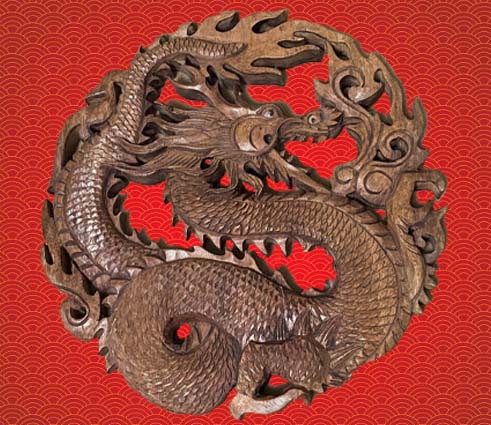On February 10th, 2024, the beginning of Year of the Wood Dragon is observed. The traditional Chinese calendar is lunar based, and February 9th is the night of the New Moon, which is why this Chinese New Year begins on 10th (and also why it is sometimes referred to as the Lunar New Year). New Year is China’s biggest celebration and there are ritual observations held for several days surrounding the holiday. The Wood Dragon marks the 41st year of the Chinese New Year cycle. This Chinese calendar established in 2637 BCE after the completion of the first cycle. Consequently, by traditional Chinese reckoning, it is the year 4721. However, with the founding of the People’s Republic of China, the Gregorian calendar was nationally adopted, under the orders of Mao Zedong.
The Chinese Dragon
Unlike the monthly astrological system used in the West, Chinese astrology is annual. Nevertheless, it is a curious coincidence that there are twelve signs in both systems. The twelve creatures in the Chinese zodiac are Rat, Ox, Tiger, Rabbit, Dragon, Snake, Horse, Sheep, Monkey, Rooster, Dog, and Pig, in that order. There are many myths about how this order came to be; the most common is that it was the result of some great race. Most stories say that the Rat cheated by tricking the Ox into giving it a ride, and then jumped ahead at the finish line.
Astute observers notice something right away about China’s celestial menagerie – there is only one mythical creature, the Dragon. The Dragon holds a very special place within Chinese cosmology and culture.
Although every culture has some manifestation of a monstrous mythical serpent, China’s ‘dragon’ is quite different from the western manifestation. Hence, the English word ‘dragon’ somewhat misconstrues the nature of the Chinese beast. In most European cultures, the term ‘dragon’ is more commonly associated with sinister beasts. Euro Dragons are typically fire-breathing winged reptiles, kidnapping damsels and guarding their treasure hordes, a malevolent creature that must be slain by heroes like Saint George. At its most extreme, this dragon is an incarnation of Satan.
The proper term for the Chinese dragon is lóng (traditional 龍; simplified 龙). It is distinct from its diabolical Western counterpart. While a lóng also has a serpentine body, that is where the similarity ends. The lóng has nine animal likenesses; only its neck resembles a snake. The other likenesses include antlers of a stag, head of a camel, eyes of a demon, belly of a clam, scales of carp, claws of an eagle, soles of a tiger, and ears of a cow. And like so many aspects of Chinese culture, there are many folk variations. These include the head of a crocodile, viscera of a tortoise, eyes of a rabbit, and more. There is even an incarnation that evokes the other eleven zodiac creatures: whiskers of the Rat, face of the Ox, claws of the Tiger, belly of the Rabbit, body of the Snake, legs of the Horse, beard of the Sheep (or goat), wit of the Monkey, crest of the Rooster, ears of the Dog, and snout of the Pig. Barring this one obscure zodiac folk list of likenesses, the number is always nine, no more, no less.
Many believe that the nine likenesses of the lóng originate from the different totems of the nine factions that were united to form China. This makes the lóng uniquely representative of China and the Emperor. Chinese people sometimes refer to themselves as the Descendants of the Dragon (lóng de chuán rén 龍的傳人). Consequently, unlike the diabolical western Dragon, the lóng is generally benevolent, ruling over weather and water. The lóng is worshipped when rain is scarce and blamed for floods and other water-related catastrophes.
Nine and five are symbolically connected to the regalness of the Emperor. Nine is the largest single digit number, while five is in the middle of odd numbers. Patterns of nine are scattered throughout the Forbidden City, from the nine-by-nine pattern of golden door nails on all the gates except one, to the Wall of Nine Dragons (Jiǔ Lóng Bì 九龍壁), one of the treasured tile murals within the Forbidden City. Even its scales follow this numerological order of number nine. It usually has 117 (9×13) scales, 81 (9×9) Yang scales and 36 (9×4) Yin scales.
The lóng also has nine sons. Known as the Nine Sons of the Dragon (Lóng shēng jiǔzǐ 龍生九子), each son is also a mythical creature but evolved into something unique. For example, Bìxì (贔屭) which is a cross between a terrapin and dragon that can carry heavy loads. Accordingly, Bìxì is typically seen as a base statue under gravestones and steles. Another is Chīwěn (蚩吻) which is cross between a fish and dragon. Chīwěn appears in ancient architecture at both ends of ridgepoles of roofs because he swallows evil. For martial artists, the most relevant is the Yázì (睚眦), a cross between a wild Asian dog and a dragon. Yázì is a fighter, so he often adorns sword guards as well as other weapons.
The Five Elements
Compounding the twelve animals of the Chinese zodiac are the Five Elements. Five Element theory is a pervasive cosmological view throughout Chinese culture. It influences everything from music, which is divided into a pentatonic scale instead of the seven-note heptatonic scale used in Western music, to Traditional Chinese Medicine. Within the martial arts, it is most prominent within Xingyiquan as well as in Qigong.
The Five Elements (Wǔxíng 五行) are Wood (mù 木), Fire (huǒ 火), Earth (tǔ 土), Metal (jīn 金), and Water (shuǐ 水). This shares three elements with the classical four elements of Fire, Earth, Water, and Air. In Chinese thought, Air is qì (氣). Beyond the ‘universal energy’ definition that we bandy about in the martial circles, qì literally means ‘air’ as well as ‘breath,’ but that’s another discussion. As for Metal, it can easily be folded into the Western element of Earth.
But what of wood? Wood is somewhat mysterious to the classical Western thinker. Wood is a symbol of growth and vitality. Mù can also be translated as ‘tree’ (it looks like a stick figure drawing of a tree). It represents strength and flexibility like bamboo (which technically speaking is a type of grass, not a type of wood, but we’d really be splitting translation hairs to quibble over that).
In Five Elements theory, there are two cycles: Creative (shēng 生) and Destructive (kè 克). In the Creative cycle, Water creates Wood and Wood creates Fire. The sequence of Chinese elements listed at the beginning of the previous paragraph is in the traditional order of the Creative cycle. Despite being a cycle, Wood is always first. In the Destructive cycle, Metal destroys Wood (think of an axe splitting a tree) and Wood destroys Earth (think of roots tearing up the ground). For practitioners of Xingyiquan and certain forms of Qigong, these cycles comprise the fundamental relationships upon which their system is based.
The Cycle of Sixty
When the twelve animals are combined with the five elements, it is called the Cycle of Sixty (12 x 5 = 60). In Chinese, this is known as Huā jiǎ zi (花甲子). Within this cycle, the animals proceed in their traditional order beginning with the Rat. The elements follow the Creative cycle starting with Wood, but just to make things complicated, each element is repeated two times. For example, this year is the Wood Dragon and next year, 2025, will be the Wood Snake. This is followed by the Fire Horse (2026 – considered as the most volatile year in the Cycle of Sixty) and then the Fire Ram (2027). Naturally, each of the sixty combinations has its own specific name. The year 2024 is called Jiǎ sheng (甲晟).
Each year in the cycle has its own unique qualities and characteristics. In proper Feng Shui prognostication, all these animals and elements are factored into the forecasts, plus more. Like so many things about Asian culture, Chinese astrology is much like a Chinese box – open one box only to discover another.
Happy New Year!
(Gōngxǐ fācái 恭喜發財)
The above is an original article by Gene Ching, Staff Writer for YMAA Publication Center.




